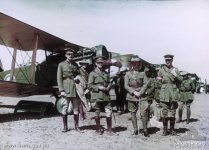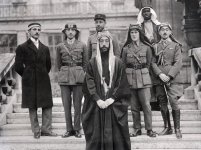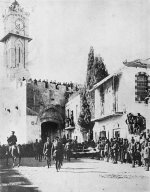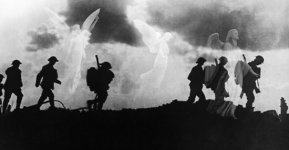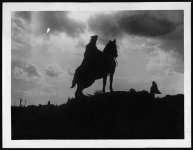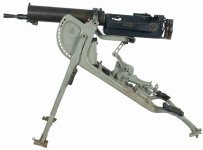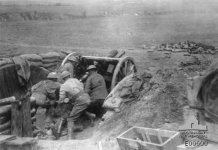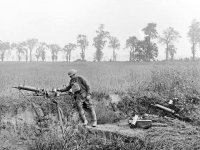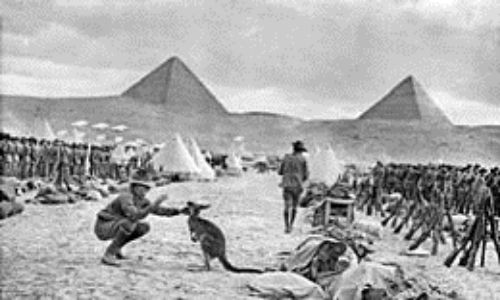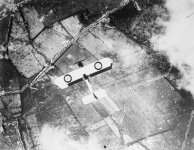You are using an out of date browser. It may not display this or other websites correctly.
You should upgrade or use an alternative browser.
You should upgrade or use an alternative browser.
WW1 Pic Of the Day (1 Viewer)
- Thread starter Rob
- Start date
Jack
Major
- Joined
- Dec 16, 2011
- Messages
- 6,347
The Military Workshop
1st Lieutenant
- Joined
- Jul 31, 2005
- Messages
- 4,778
Some 'nobs'
Wayne.
A well known photo. A bit more info as two important Australian commanders shown (Chauvel commander of Lighthorse and Richard Williams the first head of RAAF).
Lieutenant General Sir Harry Chauvel (front, second left) and Lieutenant Colonel Williams (front, second right) with No. 1 Squadron Bristol Fighters, February 1918
In June 1918, Williams was made a brevet lieutenant colonel and commander of the RAF's 40th (Army) Wing, which was operating in Palestine.[15] It comprised his former No. 1 Squadron and three British units.[1][13] As a Dominion officer, however, Williams found that he was not permitted to "exercise powers of punishment over British personnel", leading to him being temporarily "granted a supplementary commission in the Royal Air Force".[16][17] Augmented by a giant Handley Page bomber, his forces took part in the Battle of Armageddon, the final offensive in Palestine, where they inflicted "wholesale destruction" on Turkish columns.[18][19] Of 40th Wing's actions at Wadi Fara on 21 September 1918, Williams wrote: "The Turkish Seventh Army ceased to exist and it must be noted that this was entirely the result of attack from the air." He also sent Captain Ross Smith in the Handley Page, accompanied by two Bristol Fighters, to aid Major T. E. Lawrence's Arab army north of Amman when it was harassed by German aircraft operating from Deraa.[20] In November, Williams was appointed temporary commander of the Palestine Brigade,[1][21] which comprised his previous command, the 40th (Army) Wing, and 5th (Corps) Wing. His service in the theatre later saw him awarded the Order of the Nahda by the King of the Hejaz. Twice mentioned in despatches, by the end of the war Williams had established himself, in the words of RAAF historian Alan Stephens, as "the AFC's rising star".[1][13]
Air Marshal Sir Richard Williams KBE, CB, DSO (3 August 1890 – 7 February 1980) is widely regarded as the "father" of the Royal Australian Air Force (RAAF). He was the first military pilot trained in Australia, and went on to command Australian and British fighter units in World War I. A proponent for air power independent of other branches of the armed services, Williams played a leading role in the establishment of the RAAF and became its first Chief of the Air Staff (CAS) in 1922 (only 32). He served as CAS for thirteen years over three terms, longer than any other officer.
The Military Workshop
1st Lieutenant
- Joined
- Jul 31, 2005
- Messages
- 4,778
Anybody know what the blue cloth on left arm means ? Not seen it before.
waynepoo
Colonel
- Joined
- Jan 3, 2012
- Messages
- 9,797
Howard do you know? I think these blokes are signal men of some sort.Anybody know what the blue cloth on left arm means ? Not seen it before.
Wayne.
Isandlwana
Sergeant
- Joined
- Dec 2, 2007
- Messages
- 645
The Diggers are from the 10th Battalion and they are indeed signallers.
Isandlwana
Sergeant
- Joined
- Dec 2, 2007
- Messages
- 645
Martin Tabony
Command Sergeant Major
- Joined
- Nov 6, 2009
- Messages
- 2,077
Louis Badolato
Lieutenant General
- Joined
- Apr 25, 2005
- Messages
- 18,442
A rare air to air photograph showing a Royal Flying Corps aircraft in flight over trench lines
View attachment 133261
I bet Al could identify the aircraft for us!:wink2:
Users who are viewing this thread
Total: 2 (members: 0, guests: 2)



